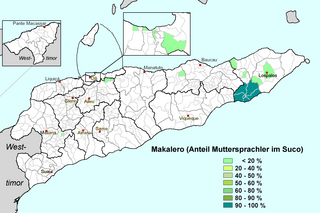Makalero
| Makalero | |
|---|---|
| Native to | East Timor |
| Region | Timor Island, eastern end around Baucau and inland, west of Fataluku, from northern to southern coast in a dialect chain. |
Native speakers | 8,000 (2017)[1] |
| Official status | |
Recognised minority language in | |
| Language codes | |
| ISO 639-3 | mjb |
| Glottolog | makl1245 |
 Distribution of Makalero mother-tongue speakers in East Timor | |
| Coordinates: 8°39′S 126°30′E / 8.650°S 126.500°E | |
Makalero or Maklere is a Papuan language spoken in the Lautém district of East Timor. It was previously considered to be a dialect of Makasae, but is nowadays seen as a separate language, both by its speakers and linguists.[1]
Phonology[edit]
The data in this section are from Huber (2017).[1]
Vowels[edit]
Makalero has five vowel phonemes. Most long vowels occur in predictable contexts; thus Huber argues long vowels are marginal phonemes at best.
| Front | Central | Back | |
|---|---|---|---|
| Close | i (i:) | u (u:) | |
| Mid | e (e:) | o (o:) | |
| Open | a (a:) |
Syllables are commonly CV; some are CVC. Epenthetic vowels are often inserted between series of two consonants, and echo vowels are often added to the end of phonological phrases.
Consonants[edit]
Makalero has 11 native consonant phonemes.
| Labial | Alveolar | Post- alveolar | Velar | Glottal | |
|---|---|---|---|---|---|
| Plosive | p | t | d̠ | k | ʔ |
| Fricative | f | s | |||
| Nasal | m | n | |||
| Trill | r | ||||
| Lateral | l |
Grammar[edit]
All information in this section is from Huber 2011.[2]
Lexical Categories[edit]
Makalero does not have a definitive noun/verb distinction. Nearly all content words can be heads of NPs as well as predicates. In the following examples, isit can be a predicate or a nominal.
Ki-isit=ee
3:POSS-ill=DEF
hai
NSIT
k-ua-misa
3:UND-on.top:RED-go.up
[2]: 98
'His illness got worse' (lit. went up on top)
Content words must be bimoraic, unlike function words, which may be monomoraic.
Valency[edit]
Makalero has only avalent verbs and divalent verbs. There are no trivalent verbs; instead, biclausal constructions are used.
The avalent verbs are adverbial verbs such as atanana 'first,' hana’e 'a long time ago,' aire’ 'now,' kamunei 'tomorrow,' mu’it 'for a long time,' raine’ 'last night,' and tone’ 'maybe.'
Divalent verbs allow for a subject and either an object or complement.
In the following example, Kiloo is the subject and ani is the object.
In the following example, ani is the subject and rau-rau is the complement.
Numerals[edit]
| 1 | unu | 11 | ruu resi nu |
|---|---|---|---|
| 2 | loloi | 12 | ruu resi loloi |
| 3 | lolitu | 13 | ruu resi lolitu |
| 4 | faata | 14 | ruu resi faata |
| 5 | lima | 15 | ruu resi lima |
| 6 | douhu | ||
| 7 | fitu | ||
| 8 | afo | ||
| 9 | siwa | ||
| 10 | ruru-u |
Notes[edit]
- ^ a b c Huber (2017)
- ^ a b c d e Huber (2011)
References[edit]
- Huber, Juliette (2011). A grammar of Makalero - A Papuan language of East Timor (Doctoral thesis). Utrecht: LOT (Leiden University). hdl:1887/17684. ISBN 9789460930607.
- Huber, Juliette (2017). "5. Makalero and Makasae". In Schapper, Antoinette (ed.). The Papuan Languages of Timor, Alor and Pantar. Pacific Linguistics 655. Vol. 2. Walter de Gruyter. pp. 267–351. doi:10.1515/9781614519027-005. ISBN 9781614519027.
External links[edit]
- Makasai at The Language Archive


 French
French Deutsch
Deutsch